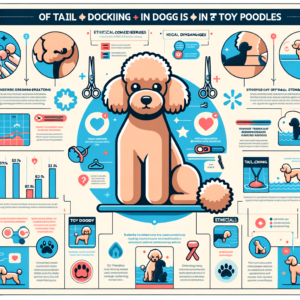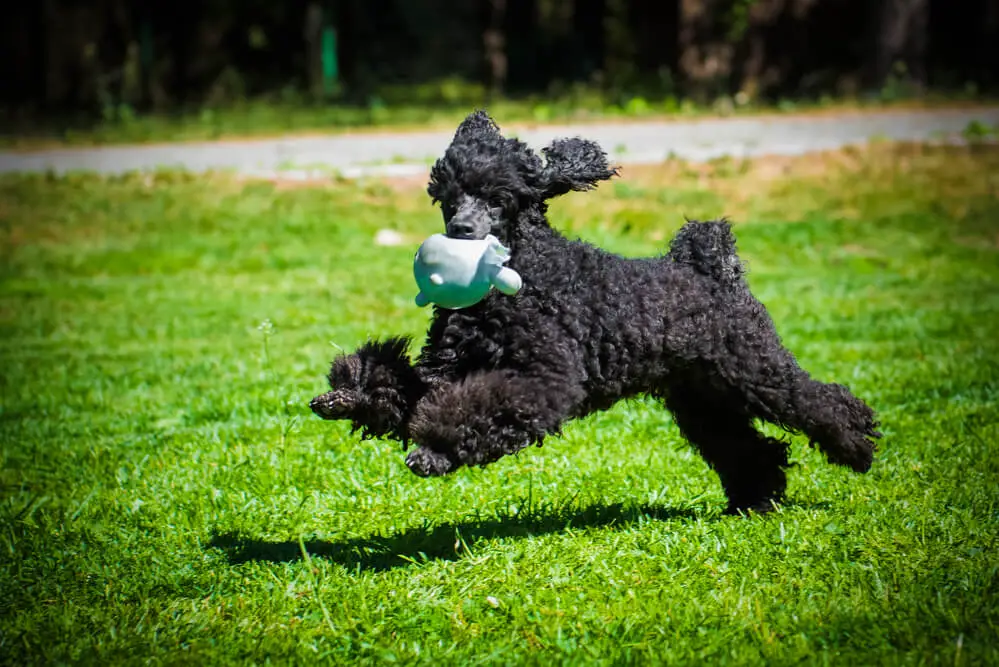Introduction to Toy Poodles and Tail Docking

As a dog lover, you might have come across the term ‘tail docking’ and wondered what it means, especially in relation to Toy Poodles. This article will provide an overview of Toy Poodles, explain what tail docking is, and delve into the history of tail docking in Toy Poodles.
-
- Overview of Toy Poodles
Toy Poodles are the smallest variety of the Poodle breed, standing at 10 inches or less at the shoulder. Despite their small size, Toy Poodles are known for their intelligence and agility. They are often characterized by their curly, dense coats and their distinctive “pom-pom” tail. However, it’s important to note that this tail appearance is not natural but a result of a practice known as tail docking.
-
- What is tail docking?
Tail docking is the process of removing a portion of a dog’s tail, usually when the dog is just a few days old. This procedure is often done without anesthesia, and it has been a subject of controversy among animal rights activists, veterinarians, and dog breeders. The practice is believed to have started for practical reasons in working dogs but has continued in some breeds for cosmetic purposes.
-
- History of tail docking in Toy Poodles
The history of tail docking in Toy Poodles dates back to the breed’s origins in Germany. Poodles were originally bred as water retrievers, and their tails were docked to prevent them from getting weighed down while swimming. Over time, tail docking in Poodles has become more of a breed standard and less of a functional necessity. However, the practice is now banned in many countries, leading to a shift in the breed’s appearance and standards.
In the following sections, we will delve deeper into the controversy surrounding tail docking, the pros and cons of the procedure, and its effects on Toy Poodles. We aim to provide you with comprehensive information to help you make informed decisions about this practice.
The Poodle Tail Docking Controversy
The practice of tail docking in toy poodles is a topic that has sparked considerable debate among dog owners, breeders, and animal rights activists. Let’s delve into the arguments for tail docking in toy poodles.
Arguments for Tail Docking in Toy Poodles
-
- Toy Poodle Breed Standards
The American Kennel Club (AKC) standards for toy poodles indicate that the tail is typically docked to maintain a balanced outline. This is a long-standing tradition in the breed, and many breeders and enthusiasts believe it helps preserve the distinctive appearance of the toy poodle.
-
- Health Benefits
Some proponents of tail docking argue that it can prevent potential health issues, such as tail injuries. However, it’s important to note that these benefits are largely anecdotal and not supported by extensive scientific research. Always consult with a trusted veterinarian before making decisions about your pet’s health.
-
- Practical Reasons
There are also practical reasons for tail docking. For instance, in the past, poodles were often used as hunting dogs. A docked tail was thought to prevent injuries when the dog was retrieving game from thorny bushes or water. Today, while most toy poodles are not used for hunting, some people still dock their tails for practical reasons, such as ease of grooming.
Arguments Against Tail Docking in Toy Poodles
-
- Tail docking ethics
The ethical considerations surrounding tail docking in toy poodles are significant. Many animal rights activists argue that tail docking is an unnecessary procedure that causes pain and discomfort to the dog. They believe that it’s a form of cosmetic surgery that serves no real purpose for the dog’s health or well-being. According to the Animal Welfare Act, unnecessary pain and suffering should be avoided, and many believe tail docking falls into this category.
-
- Potential health risks
Like any surgical procedure, tail docking comes with potential health risks. These can include infection, excessive bleeding, and an adverse reaction to anesthesia. In some cases, the procedure can lead to chronic pain or nerve damage. A study published in the Veterinary Record found that dogs that had their tails docked were more likely to develop problems with their anal glands.
-
- Effects on dog’s communication
Dogs use their tails as a significant form of communication with both humans and other dogs. A wagging tail can express happiness, while a tucked tail often indicates fear or submission. By docking a toy poodle’s tail, we may be limiting their ability to communicate effectively. This can lead to misunderstandings and behavioral problems. According to the Dog Communication page on Wikipedia, tail movements form a crucial part of a dog’s body language.
Pros and Cons of Tail Docking
When it comes to tail docking in toy poodles, there are both advantages and disadvantages to consider. In this section, we will explore the pros of this practice.
Pros of Tail Docking in Toy Poodles
There are several reasons why some toy poodle owners and breeders choose to dock their dogs’ tails. Let’s take a closer look at these reasons:
- Prevention of tail injuries: One of the main reasons for tail docking in toy poodles is to prevent potential tail injuries. As these dogs are small and active, their tails can easily get caught or injured during play or exercise. By docking the tail, the risk of such injuries is significantly reduced.
- Upholding breed standards: Tail docking is a traditional practice in many dog breeds, including toy poodles. It is often done to uphold breed standards set by dog breed organizations. Some believe that a docked tail is a defining characteristic of the toy poodle breed.
- Enhanced appearance: Many toy poodle owners and breeders believe that a docked tail enhances the dog’s appearance, giving it a more balanced and elegant look. This is particularly important for show dogs, where appearance plays a significant role in judging.
While these are some of the pros of tail docking, it’s important to consider the cons as well. In the next section, we will discuss the potential downsides of this practice.
Cons of Tail Docking in Toy Poodles
While tail docking in toy poodles is a common practice, it’s important to consider the potential downsides. Here are some of the key disadvantages:
-
- Potential pain and discomfort: Tail docking is a surgical procedure that can cause significant pain and discomfort for the dog. Even with the use of anesthesia, the recovery period can be uncomfortable. Studies have shown that puppies can experience pain from docking, which can affect their behavior and well-being.
-
- Risk of infection or complications: As with any surgical procedure, tail docking carries a risk of infection or complications. These can range from minor issues, such as skin irritation or wound dehiscence, to more serious problems like septicemia or nerve damage.
- Impact on dog’s balance and mobility: The tail plays a crucial role in a dog’s balance and mobility. It acts as a counterbalance when the dog is running or jumping, and it helps with turning and maneuvering. Docking the tail can potentially impact a toy poodle’s agility and coordination.
In conclusion, while tail docking in toy poodles may have its advantages, it’s crucial to weigh these against the potential cons. It’s always important to consider the welfare and comfort of our furry friends above all else.
The Toy Poodle Tail Docking Procedure
One of the most common procedures performed on Toy Poodles is tail docking. This procedure, which involves the removal of a portion of the dog’s tail, is often done for aesthetic reasons. Let’s delve into the specifics of when it’s performed, how it’s done, and what post-procedure care entails.
-
- When is tail docking performed?
Tail docking is typically performed on Toy Poodles when they are just a few days old. According to the American Kennel Club, the procedure is usually done before the puppy’s eyes are open and before their ear canals have fully formed. This is because the nerves in the tail are not fully developed at this stage, which can make the procedure less painful.
-
- How is the procedure done?
The tail docking procedure is usually performed by a veterinarian or a breeder with experience in the procedure. The tail is first cleaned and then a rubber band is placed tightly around the tail at the point where the tail will be docked. This cuts off the blood supply to the end of the tail, causing it to fall off after a few days. Alternatively, a scalpel can be used to cut off the tail. The wound is then cleaned and bandaged.
-
- Post-procedure care and recovery
After the tail docking procedure, the Toy Poodle puppy will need some special care. The bandage on the tail needs to be kept clean and dry to prevent infection. The puppy should be monitored closely for signs of discomfort or distress. If the puppy seems to be in pain, a trip to the vet is necessary. The tail will heal over a period of a few weeks, and the puppy can then go on to lead a normal, healthy life.
In conclusion, tail docking is a common procedure performed on Toy Poodles. It is important to understand the procedure, its timing, and the necessary post-procedure care to ensure the health and well-being of the puppy.
Effects of Tail Docking on Toy Poodles
Tail docking is a procedure that has been practiced for centuries, but it’s not without its consequences. Let’s delve into the physical, psychological, and social impacts it can have on toy poodles.
- Physical effects: Tail docking can cause immediate physical pain to the toy poodle. The tail is a part of the dog’s body filled with nerves and muscles. When it’s cut, the dog can experience severe discomfort. In some cases, complications such as infection or improper healing can occur, leading to long-term health issues. According to a study published on Wikipedia, dogs that have undergone tail docking are more likely to develop issues with their hindquarters and lower back.
- Psychological effects: The psychological effects of tail docking on toy poodles are not to be overlooked. Dogs use their tails as a means of communication. When a dog’s tail is docked, it may feel confused or frustrated because it can’t express itself properly. This can lead to stress, anxiety, and other psychological issues. A study referenced on Wikipedia indicates that dogs with docked tails may show signs of increased aggression or fear compared to those with intact tails.
- Impact on behavior and social interaction: A docked tail can also affect a toy poodle’s social interactions. Dogs use their tails to communicate with other dogs and humans. A docked tail can limit this communication, leading to misunderstandings and potentially harmful situations. For instance, a dog with a docked tail might not be able to signal submission or fear effectively, leading to increased chances of conflict with other dogs. According to a Wikipedia article, dogs with docked tails can sometimes be misinterpreted by other dogs, leading to social conflicts.
In conclusion, while tail docking is a common practice, it’s important for toy poodle owners to understand the potential physical, psychological, and social impacts it can have on their pets. This knowledge can help them make informed decisions about whether to dock their dog’s tail or not.
Should Poodles Have Their Tails Docked?
Deciding whether or not to dock your poodle’s tail is a decision that should not be taken lightly. It involves considering various factors, seeking professional opinions, and examining case studies. Let’s delve into these aspects in detail.
-
Considerations for Pet Owners
As a pet owner, it’s crucial to understand the implications of tail docking. First, consider the health and well-being of your poodle. Tail docking is a surgical procedure that can cause pain and discomfort. Secondly, think about the purpose. If your poodle is not a show dog, tail docking might not be necessary. Lastly, consider the ethical aspect. Some people view tail docking as a form of unnecessary cosmetic surgery.
-
Professional Opinions
Many veterinarians and animal welfare organizations oppose tail docking for non-medical reasons. The American Veterinary Medical Association discourages the practice, stating that it provides no health benefits and can cause distress. However, some breeders argue that it’s a long-standing tradition in certain breeds like the poodle.
-
Case Studies
Several case studies have been conducted on the effects of tail docking. A study found that tail docking can interfere with a dog’s ability to communicate with other dogs and humans, leading to behavioral problems. Another study suggested that dogs that have their tails docked might experience phantom pain.
In conclusion, the decision to dock your poodle’s tail should be made after careful consideration of all the factors mentioned above. It’s always best to consult with a professional veterinarian before making such a decision.
Conclusion: To Dock or Not to Dock?
In this comprehensive guide, we have explored the topic of tail docking in toy poodles, a subject that has sparked much debate among dog owners and animal rights activists alike. Let’s summarize the key points and share some final thoughts.
-
- Summary of Key Points
Firstly, we delved into the history of tail docking, explaining that it was originally done for practical reasons, but is now mostly carried out for cosmetic purposes. We discussed the controversy surrounding the practice, with some arguing that it is unnecessary and cruel, while others maintain that it is a part of the breed’s standard.
We examined the pros and cons of tail docking, highlighting that while some believe it can prevent future injuries and maintain the breed’s look, others argue that it can cause pain and potential health issues. We also explained the procedure itself, which is usually performed when the puppies are just a few days old.
Lastly, we discussed the effects of tail docking on toy poodles, noting that while some dogs seem to adjust well, others may experience changes in behavior or movement. The decision to dock or not is ultimately up to the owner, but it’s crucial to make an informed choice that considers the dog’s health and well-being.
-
- Final Thoughts
In conclusion, tail docking is a complex issue with strong arguments on both sides. It’s essential for potential toy poodle owners to research thoroughly and consult with professionals before making a decision. Remember, the health and happiness of your pet should always be the top priority. Whether you choose to dock or not, providing a loving and caring environment for your toy poodle is what truly matters.
For further reading on this topic, you can visit the Wikipedia page on dog tail docking.














